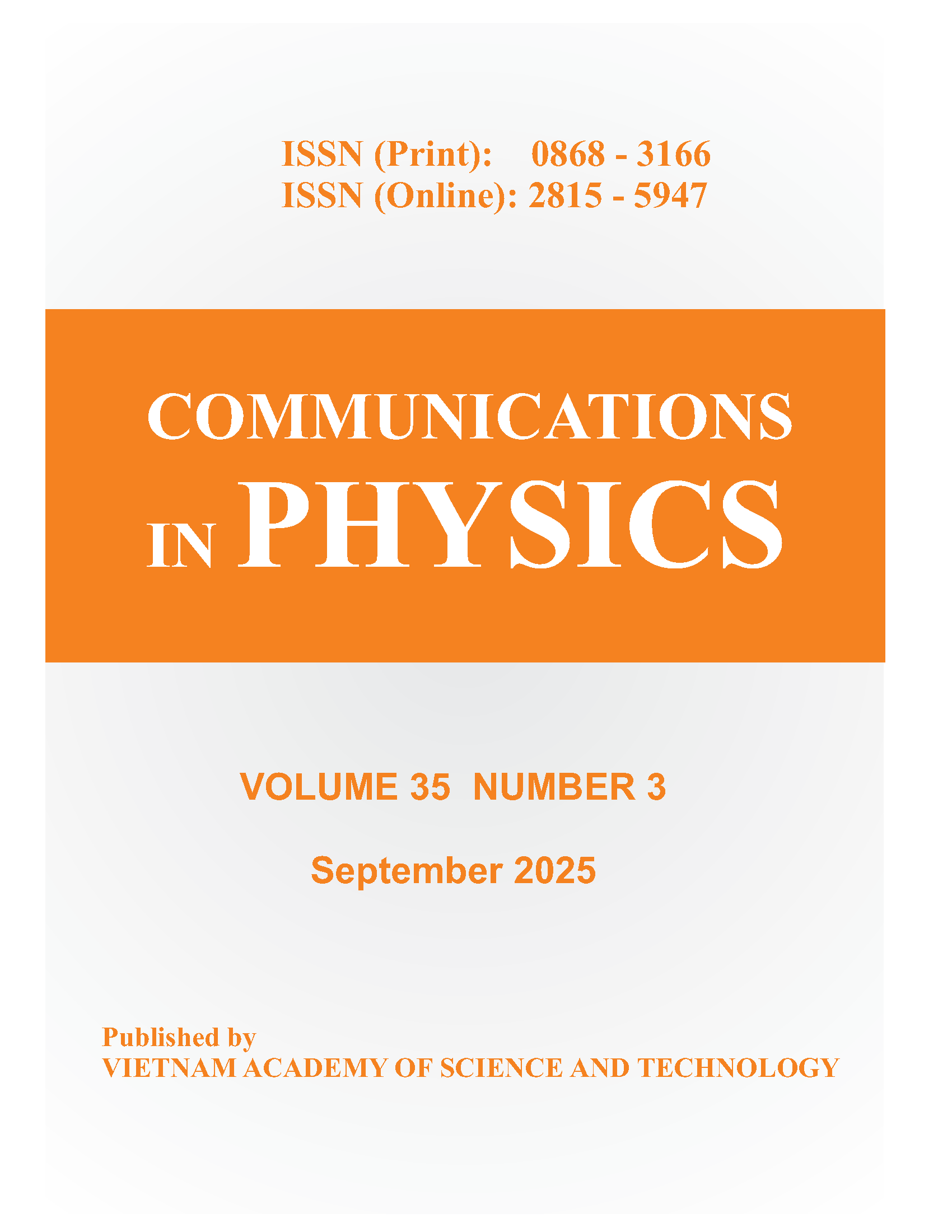Liquid-gated Field-effect-transistor Based on Chemically Reduced Graphene Oxide for Sensing Neurotransmitter Acetylthiocholine
Author affiliations
DOI:
https://doi.org/10.15625/0868-3166/16737Keywords:
hydrazine, graphene oxide, acetylcholinesterase, FETAbstract
In this work, an enzymatic liquid-gated field-effect-transistor sensor based on chemically reduced graphene oxide film was develop for determination of acetylthiocholine in aqueous conditions. The device was designed with interdigitated electrode configuration and then manufactured by combining lithography and chemical vapor deposition techniques in clean room. Graphene oxide material (prepared by Hummer method) was chemically reduced using a strong reducing agent hydrazine, and then drop-casted onto the channel region. The results have demonstrated a successful reduction of graphene oxide with clearly shifting of 02 characteristic peaks comparing with graphene oxide. Consequently, the transfer curve of as-prepared reduced graphene oxide based transistor exhibits ambipolar characteristics with a V-shape. Acetylcholinesterase was immobilized on top of reduced graphene oxide film with the aid of glutaraldehyde trapping agent. It was found that the release of proton from enzymatic hydrolysis of acetylthiocholine has caused significant variation in charge concentration and mobility in the channel, thus generated a significant blue shift in position of Dirac point on ambipolar curve. The developed sensor exhibits good sensing performances with LOD of 250 µM in concentration range 0 – 0.8 mM.
Downloads
References
P. Aspermair, V. Mishyn, J. Bintinger, H. Happy, K. Bagga, P. Subramanian, W. Knoll, R. Boukherroub, S. Szunerits, Analytical and Bioanalytical Chemistry 413 (2021) 779.
X. Sui, H. Pu, A. Maity, J. Chang. B. Jin, G. Lu, Y. Wang, R. Ren, S. Mao and J. Chen, ECS Journal of Solid State Science and Technology 9 (2020) 115012.
J. Sengupta and C. M. Hussain, Carbon Ttrens 2 (2021).
D. Wu, H. Zhang, D. Jin, D. W. Pang, M. M. Xiao, Z. L. Zhang, Z. Y. Zhang, Analyst 144 (2019) 6055.
T. Q. Trung, N. T. Tien, D. Kim, M. Jang, O. J. Yoon and N. –E. Lee, Adv.Funct. Mater.(2013).
C. R. Rozman, A. Kotlowski and W. Knoll, Biosensors 6 (2016).
M. Hasegawa, Y. Hirayama, Y. Ohno, K. Maehashi and K. Matsumoto, Jpn. J. Appl. Phys 53 (2014).
T. Quast, F. Mariani, E. Scavetta, W. Schuhmann and C. Andronescu, ChemElectroChem 7 (2020) 1922.
M. Sun, C. Zhang. D. Chen, J. Wang, Y. Ji, N. Liang, H. Gao, S. Cheng and H. Liu, SmartMat. 2 (2021) 213.
A. D. Rashid, A. R. Ruslinda, M. F. Fatin, U. Hashim, M. K. Arshad, AIP Conf Proc. 1733 (2015) 020076.
X. Jin, H. Zhang, Y. T. Li, M. M. Xiao, Z. L. Zhang, D. W. Pang, G. Wong, Z. Y. Zhang, G. J. Zhang, Microchimica Acta (2019) 186.
M. S. Chae, Y. K. Yoo, J. Kim. T. G. Kim. K. S. Hwang, Sensors and Actuators B 272 (2018) 448.
P. Bhattacharyya, IEEE Sensors Journal, 21 (2021) 10231.
N. T. Lan, D. T. Chi, N. X. Dinh, N. D. Hung, H. Lan, P. A. Tuan, L. H. Thang, N. N. Trung, N. Q. Hoa, T. Q. Huy. N. V. Quy, T. T. Duong, V. N. Phan, A. T. Le, Journal of Alloys and Compounds 615 (2014) 843.
M. R. Martínez, M. A. Álvarez, M. V. L. Ramón, G. C. Quesada, J. R. Utrilla and M. S. Polo, Catalysts 10 (2020) 520.
H. Su, C. Zhang, X. Li, L. Wu and Y. Chen, RSC Adv. 8 (2018) 39140.
D. Konios, M. M. Stylianakis, E, Stratakis, E. Kymakis, Journal of Colloid and Interface Science 430 (2014) 108.
A. C. Ferrari, Solid State Communications 143 (2007) 47.
V. Scardaci and G. Compagnini, C 7 (2021) 48.
M. Srivastava, A. K. Das, P. Khanra, M. E. Uddin, N. H. Kim and J. H. Lee, J. Mater. Chem. A 1 (2013) 9792.
J. Ding, S. Zhu, T. Zhu, W. Sun, Q. Li, G. Wei and Z. Su, RSC Adv. 5 (2015( 22935.
C. T. Thanh, N. H. Binh, N. V. Tu, V. T. Thu, M. Bayle, M. Pailler, J. L. Sauvajol, P. B. Thang, T. D. Lam, P. N. Minh, N. V. Chuc, Sensors and Actuators B 260 (2018) 78.
T. T. Cao, V. C. Nguyen, H. B. Nguyen, H. T. Bui, T. T. Vu, N. H. Phan, B. T. Phan, l. Hoang. M. Bayle, M. Paillet, J. L. Sauvajol, N. M. Phan, D. L. Tran, Adv. Nat. Sci. Nanosci. Nanotechnoli 7 (2016) 035007.
T. T. Vu, T. N. N. Dau, C. T. Ly, D. C. Pham, T. T. N. Nguyen and V. T. Pham, J Mater Sci (2020).
I. -Y. Sohn, D. -J. Kim, J. -H. Jung, O. J. Yoon, T. N. Thanh, T. T. Quang, N. -E. Lee, Biosensors and Bioelectronics 45 (2013) 70.
C. R. Rozman, M. Larisika, C. Nowak, W. Knoll, Biosensors and Bioelectronics 70 (2015) 21.
Downloads
Published
How to Cite
Issue
Section
License
Communications in Physics is licensed under a Creative Commons Attribution-ShareAlike 4.0 International License.
Copyright on any research article published in Communications in Physics is retained by the respective author(s), without restrictions. Authors grant VAST Journals System (VJS) a license to publish the article and identify itself as the original publisher. Upon author(s) by giving permission to Communications in Physics either via Communications in Physics portal or other channel to publish their research work in Communications in Physics agrees to all the terms and conditions of https://creativecommons.org/licenses/by-sa/4.0/ License and terms & condition set by VJS.












